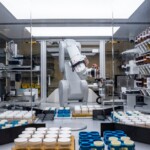Crystals exhibit a diverse range of functionalities, each with its own level of usefulness. While they are sometimes misused in New Age healing shops, crystals also serve crucial roles such as capturing light in solar panels, aiding industrial reactions for producing substances like ammonia and nitric acid, and providing the necessary silicon for microchips. The vast diversity among crystals arises from their classification as a broad group of compounds united by their atomic structure consisting of repeating units—the three-dimensional equivalent of interlocking tiles.
The extent of this diversity is highlighted in a study by Google DeepMind, an artificial intelligence entity, published in the esteemed journal Nature. The scientific community is familiar with approximately 48,000 unique crystals, each distinguished by a specific chemical composition. DeepMind has developed a machine-learning tool named GNoME (Graph Networks for Materials Exploration) to forecast novel crystal structures by utilizing existing databases of chemical configurations. Remarkably, this tool generated 2.2 million previously unknown crystal structures.
To validate the machine’s predictions, DeepMind collaborated on another research, also featured in Nature, with scholars from the University of California, Berkeley. By selecting 58 compounds from the projected list, they successfully synthesized 41 within just over two weeks. Notably, since the inception of their study, various research groups have produced over 700 additional crystals.
To facilitate further research by interested laboratories on the multitude of crystals identified by the computer, DeepMind has released a subset believed to include the 381,000 most stable structures. This compilation comprises numerous crystals with configurations that could promote superconductivity, allowing the smooth flow of electrical currents without resistance, as well as several hundred promising lithium ion conductors with applications in battery technology. DeepMind’s efforts have significantly broadened the range of potential materials available to researchers in these fields.
Despite receiving praise for its achievements, DeepMind’s initiative is seen as just the beginning of a broader exploration. Aron Walsh, a materials scientist at Imperial College London, commends the work but notes that this is only scratching the surface of the possibilities. He highlights that the machine’s analysis was limited to crystals forming under specific low-temperature and low-pressure conditions. Furthermore, crystals represent only a fraction of the vast array of materials, including everything from glassy solids to gases, gels, and liquids.
The practical applications of the 2.2 million newly discovered crystals remain uncertain. Nevertheless, the methodologies used in making these forecasts are inherently valuable. Apart from suggesting new crystals, artificial intelligence has the potential to unveil previously undiscovered principles governing their formation.
Ekin Dogus Cubuk from DeepMind reveals a significant finding in this area. Previously considered rare, crystals composed of six elements, known as senaries, were unexpectedly abundant in DeepMind’s analysis, numbering around 3,200 among the 381,000 stable compounds examined. A comprehensive understanding of crystal formation and the range of possibilities could save curious scientists from the tedious task of manually synthesizing each of the 2.2 million new materials to explore their properties.






